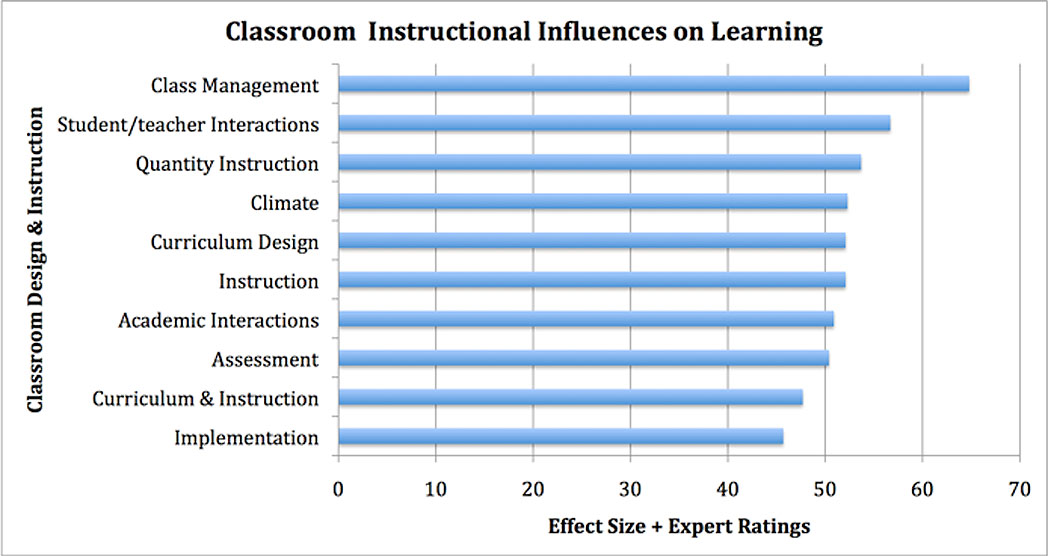What are the critical influences in a classroom that result in improved student performance?
Why is this question important? If we know which variables have the greatest influence on student learning, we can systematically arrange classroom environments to maximize these influences, thus improving student performance. Understanding what works in an exemplary classroom can assist Teacher Preparation Programs design curricula that capitalize on these best practices and skills.
See further discussion below.
Source:(1) What Helps Students Learn? (1997), and (2) Learning Influences (1994)
Results: The analysis found that direct influences on students have a greater impact on student performance than all other variables. Direct influences include those activities involving actual teaching that takes place in a classroom. The study distilled 28 categories of influences on student learning. By combining the effect size of different practices derived from the accumulated research along with a content analysis and a survey of educational experts, a weighted score was provided for each of the 28 categories. All three independent sources used in the analysis generally agreed on the impact of the 28 variables influencing learning. The 28 categories were subdivided into 6 groupings: student characteristics; classroom instruction and climate (the primary categories used in the Wing Institute chart); home, peers, and community; program design; school organization; and state and district policy. The study found that state and district policy provided the smallest impact on improving student performance. Interestingly, this is true despite this grouping having received the most attention over the past 20 years.
The Wang, Haertel, and Walberg analysis should be replicated and more rigorous methods employed. However, unless more rigorous methods are employed, a new analysis might result in variability of the results without offering greater confidence in our knowledge base.
Implications: There are two critical conclusions that are readily derived from this study: (1) Policy solutions appear to be the least powerful variables. Unfortunately, these have dominated education reform during the past 30 years, and in line with the conclusions of the study they have not improved student achievement. This is evidenced through many measures including the flat NAEP scores since the 1970s. (2) Efforts to reform the education system in the United States should be redirected to classroom practices that are supported by this study as well as other reputable research.
Authors: (both articles) M. C. Wang, G. D. Haertel, and H. J. Walberg
Publisher: Temple University Center for Research in Human Development and Education, and McCutchan Publishing
Study Description: The research is a meta-analysis of 179 book chapters and studies consisting of 91 research syntheses and a survey of 61 researchers. The data displayed in the above chart was transformed into T scores with a mean of 50 and standard deviation of 10. The relative influences of the variables (classroom design and instruction) were calculated by weighing composites of effect sizes, ratings obtained from experts, and content analyses of the literature. The resulting analysis pooled with a content analysis revealed a general consensus on the most important variables that influence student learning. The Wing Institute chart encompasses only those direct influences at the classroom level identified in the study and represents only 10 of the 28 categories reviewed.
Definitions:
- Effect Size + Expert Ratings: The relative influence and power of variables on student performance as calculated by weighing effect sizes, content analysis, and ratings obtained from educational experts.
- . Classroom management: Teachers use of questioning and recitation strategies to maintain active participation of students.
- Student/teacher interactions: Positive student response to questions from teacher and other students.
- Quantity of instruction: Teachers active engagement in students learning.
- Classroom climate: Cohesiveness (class members have common interests, values, and emphasize cooperative goals).
- Curriculum design: Instructional materials that employ advance organizers.
- Instruction: Clear and organized direct instruction.
- Academic Interactions: Frequent requests for substantive oral and written responses.
- Assessment: Assessment is used as a frequent and integral part of instruction. Assessment is the process of gathering observable and measurable information on a student’s current knowledge or skills.
- Curriculum & instruction: Alignment of goals, content, instruction, student assignments, and evaluation.
- Implementation & support: Efficient classroom routines and communication of rules and procedures.
Citation: (1) Wang, M., Haertel, G., and Walberg, H., What Helps Students Learn? (1997) and (2) Wang, M., Haertel, G., and Walberg, Psychology and Educational Practices (1994)

